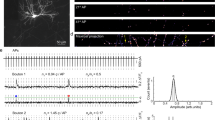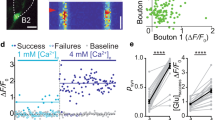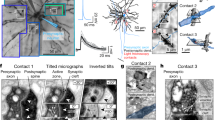Abstract
Why synapses release a certain amount of neurotransmitter is poorly understood. We combined patch-clamp electrophysiology with computer simulations to estimate how much glutamate is discharged at two distinct central synapses of the rat. We found that, regardless of some uncertainty over synaptic microenvironment, synapses generate the maximal current per released glutamate molecule while maximizing signal information content. Our result suggests that synapses operate on a principle of resource optimization.
This is a preview of subscription content, access via your institution
Access options
Subscribe to this journal
Receive 12 print issues and online access
$209.00 per year
only $17.42 per issue
Buy this article
- Purchase on Springer Link
- Instant access to full article PDF
Prices may be subject to local taxes which are calculated during checkout


Similar content being viewed by others
References
Oertner, T.G., Sabatini, B.L., Nimchinsky, E.A. & Svoboda, K. Nat. Neurosci. 5, 657–664 (2002).
Christie, J.M. & Jahr, C.E. J. Neurosci. 26, 210–216 (2006).
Nielsen, T.A., DiGregorio, D.A. & Silver, R.A. Neuron 42, 757–771 (2004).
Cathala, L., Holderith, N.B., Nusser, Z., DiGregorio, D.A. & Cull-Candy, S.G. Nat. Neurosci. 8, 1310–1318 (2005).
Wadiche, J.I. & Jahr, C.E. Neuron 32, 301–313 (2001).
Sylantyev, S. et al. Science 319, 1845–1849 (2008).
Silver, R.A., Colquhoun, D., Cull-Candy, S.G. & Edmonds, B. J. Physiol. (Lond.) 493, 167–173 (1996).
Savtchenko, L.P. & Rusakov, D.A. Proc. Natl. Acad. Sci. USA 104, 1823–1828 (2007).
Zheng, K., Scimemi, A. & Rusakov, D.A. Biophys. J. 95, 4584–4596 (2008).
Takamori, S. et al. Cell 127, 831–846 (2006).
Stevens, C.F. & Zador, A. Curr. Biol. 5, 1370–1371 (1995).
Zador, A. J. Neurophysiol. 79, 1219–1229 (1998).
Cover, T.M. & Thomas, J.A. Elements of Information (Wiley, New York, 1991).
Williams, S.R. & Mitchell, S.J. Nat. Neurosci. 11, 790–798 (2008).
Alle, H., Roth, A. & Geiger, J.R. Science 325, 1405–1408 (2009).
Harris, J.J., Jolivet, R. & Attwell, D. Neuron 75, 762–777 (2012).
Cuntz, H., Mathy, A. & Hausser, M. Proc. Natl. Acad. Sci. USA 109, 11014–11018 (2012).
Friston, K. Nat. Rev. Neurosci. 11, 127–138 (2010).
Colquhoun, D., Jonas, P. & Sakmann, B. J. Physiol. (Lond.) 458, 261–287 (1992).
Hines, M.L. & Carnevale, N.T. Neuroscientist 7, 123–135 (2001).
Magee, J.C. & Cook, E.P. Nat. Neurosci. 3, 895–903 (2000).
Migliore, M. J. Comput. Neurosci. 14, 185–192 (2003).
Acknowledgements
The authors thank A. Silver, D. Kullmann and K. Volynski for comments, and P. Michaluk for help with granule cell cultures. This work was supported by the Wellcome Trust, UK Medical Research Council, European Research Council Advanced Grant, and Biotechnology and UK Biological Sciences Research Council.
Author information
Authors and Affiliations
Contributions
L.P.S. conducted theoretical studies and simulations; S.S. carried out experiments and analyzes; D.A.R., L.P.S. and S.S. designed the study; D.A.R. wrote the paper, which was further edited by all authors.
Corresponding author
Ethics declarations
Competing interests
The authors declare no competing financial interests.
Supplementary information
Supplementary Text and Figures
Supplementary Figures 1–5 (PDF 630 kb)
Rights and permissions
About this article
Cite this article
Savtchenko, L., Sylantyev, S. & Rusakov, D. Central synapses release a resource-efficient amount of glutamate. Nat Neurosci 16, 10–12 (2013). https://doi.org/10.1038/nn.3285
Received:
Accepted:
Published:
Issue Date:
DOI: https://doi.org/10.1038/nn.3285
This article is cited by
-
Multiplex imaging relates quantal glutamate release to presynaptic Ca2+ homeostasis at multiple synapses in situ
Nature Communications (2019)
-
Disentangling astroglial physiology with a realistic cell model in silico
Nature Communications (2018)
-
Nanoscale diffusion in the synaptic cleft and beyond measured with time-resolved fluorescence anisotropy imaging
Scientific Reports (2017)
-
Hybrid Markov-mass action law model for cell activation by rare binding events: Application to calcium induced vesicular release at neuronal synapses
Scientific Reports (2016)
-
Neuronal activity controls transsynaptic geometry
Scientific Reports (2016)



